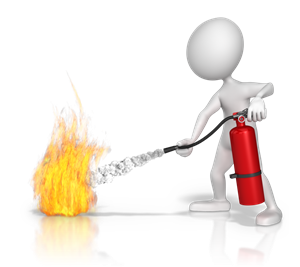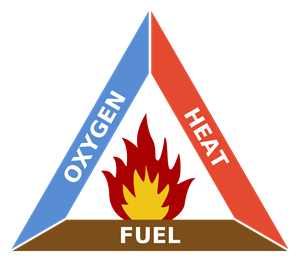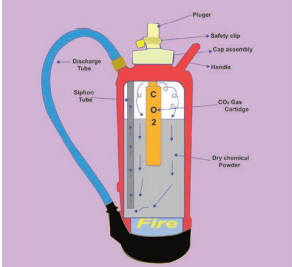PDF chapter test TRY NOW
Fire control and fire extinguisher


Fire extinguisher
The conditions required for making fire are,
- fuel
- oxygen
- heat
Fire triangle:

Fire triangle
Apart from the three conditions to make fire, one more element is also essential to produce fire, that is "chemical reaction" between them.
Fire can be controlled by removing any of these three or all the three.
Fire extinguisher:
It is a device used to remove fire or control burning.
Working of a fire extinguisher:

Working of a fire extinguisher
Image credits: TNSB class 7 Unit 4 (Chemistry in daily life)
Fire extinguisher produces an agent called extinguishing agent, which either cools the burning fuel or displaces oxygen or removes oxygen or breaks off the chemical reaction; hence it does not continue to burn. If we compress the extinguisher's candle, it opens, and the inner cylinder of the high-pressure gases forces the extinguishing agent via siphon tube then out the nozzle.
The working of fire extinguisher is similar to hair spray.
Types of fire extinguishers:
There are five types of fire extinguishers.
- Water
- Foam
- Dry chemical powder
- Carbon dioxide
- Wet chemical
Type of extinguishers | Work | Can be used for | Cannot be used for |
| Water | It contains de-ionised water. The extinguisher is used to control or cut off the fire involving solid, wood and papers. | Combustible materials (Example, paper, wood) | Flammable liquids, flammable gases, electrical equipment and deep fat fryers |
| Foam | It contains sodium bicarbonate and aluminium sulphate. Foam extinguishes the liquid fire by sealing the liquid's surface. The foam prevents the flammable vapour from reaching the air. | Combustible materials and flammable liquids | Domestic use |
| Dry powder | It consists of sodium bicarbonate. This extinguisher extinguishes the fire by interrupting the chemical reaction that takes place and stops the oxygen supply. | Combustible materials and flammable liquids, metals, gases, electrical equipment | Deep fat fryers (Example, chip pans) |
| Carbon dioxide | It contains non-flammable carbon dioxide under high pressure. It extinguishes fire by displacing oxygen or taking away oxygen. Also, carbon dioxide cools the fuel. | Flammable liquids, electrical equipment. | Combustible materials, flammable metals, gases, deep fat fryers. |
| Wet chemical | It contains potassium solution, which attacks the fire. | Combustible material and deep fat fryers | Flammable liquids, metals, gases, electrical equipment and deep fat fryer. |
The most commonly used extinguishers are,
- air pressurised water extinguisher
- carbon dioxide extinguisher
- dry chemical powder extinguisher
Also, there are six classes of fire:
- Class A - Combustible material: This fire is caused by flammable solids like cloth, wood.
- Class B - Flammable liquids: This fire is caused by petrol, paint.
- Class C - Flammable gases: This fire is caused by hydrogen, butane, methane.
- Class D - Combustible metals: This fire is caused by magnesium, aluminium, potassium.
- Class E: This fire is normally caused by chip-pan fire.
- Electrical fire - Combustible material: This is caused by faulty outlets or old or outdated appliances.
Reference:
https://th.bing.com/th/id/R.329dfa9565cab9295cb581b0d5e2d5dc?rik=w4tAn8cLil%2bONA&riu=http%3a%2f%2fpngimg.com%2fuploads%2fextinguisher%2fextinguisher_PNG47.png&ehk=k%2bxeWT%2ba7Tws6ZQcwfzuE95bwPJfHg4t35AHaUztGgc%3d&risl=&pid=ImgRaw&r=0
